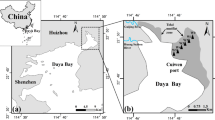Abstract
The work assessed effect of diurnal tidal fluctuation on transient groundwater dynamics with special focus on trace metal mobilization using tide-aquifer interaction technique in the Saijo plain, Japan. Fluctuation of trace metal concentration in groundwater during intertidal phase obtained through geochemical analysis is validated with numerical simulation using two different codes (PHREEQC and SEEP/W) to observe saturation index for different minerals in aquifers and dynamics of submarine groundwater discharge (SGD) respectively. Result for saturation index shows that most of the samples are strongly undersaturated with respect to FeS, goethite, siderite and scorodite, unlike pyrite where it approaches towards saturation. Also during lower low tide situation, water samples relatively getting more undersaturated with pyrite suggesting it as a source for dissolved iron. For numerical simulation, problem domain consists of 368 elements and 3 layers, is an anisotropic unconfined aquifer with horizontal hydraulic conductivities (K X ) ranging from 0.00001 to 0.01 m/P. Coastal side of the domain considered as variable head boundary keeping different diurnal tidal amplitude into account. Simulation result shows that during low tide situation, value of SGD is maximum i.e. 2.1644e−005 and 3.3704e−005 m3/s for lower boundary towards sea at 2 and 4 m below mean sea level respectively. It suggests that tidal height affects the amount and position of SGD to play a positive role for trace metal mobilization through oxidation–reduction process. Strong relation between diurnal fluctuations of the simulated results (SGD) versus observed result oxidation–reduction potential firmly supports and validates the results from chemical analysis.








Similar content being viewed by others
References
Kumar P, Tsujimura M, Nakano T, Minoru T (2013) Time series analysis for the estimation of tidal fluctuation effect on different aquifers in a small coastal area of Saijo plain, Ehime prefecture, Japan. Environ Geochem Health 35:239–250
Steyl G, Dennis I (2010) Review of coastal-area aquifers in Africa. Hydrogeol J 18:217–225
Kim KY, Seong H, Kim T, Park K, Woo N, Park Y, Koh G, Park W (2006) Tidal effects on variations of fresh–saltwater interface and groundwater flow in a multilayered coastal aquifer on a volcanic island (Jeju Island, Korea). J Hydrol 330:525–542
Robinson C, Li L, Barry DA (2007) Effect of tidal forcing on a subterranean estuary. Adv Water Resour 30:851–865
Shalev E, Lazar A, Wollman S, Kington S, Yechieli Y, Gvirtzman H (2009) Biased monitoring of fresh water-salt water mixing zone in coastal aquifers. Ground Water 47:49–56
Li L, Barry DA, Parlange JY, Pattiaratchi CB (1997) Beach water table fluctuation due to wave run-up: capillary effects. Water Resour Res 33(5):935–945
Gibbes B, Robinson C, Li L, Lockington D (2007) Measurement of hydrodynamics and pore water chemistry in intertidal groundwater systems. J Coast Res SI 50:884–894
Turner I (1993) The total water content of sandy beaches. J Coast Res 15:11–26
Jorgensen NO, Andersen MS, Engesgaard P (2008) Investigation of a dynamic seawater intrusion event using strontium isotopes (87Sr/86Sr). J Hydrol 348:257–269
Langman JB, Ellis AS (2010) A multi-isotope (δD, δ18O, 87Sr/86Sr, and δ11B) approach for identifying saltwater intrusion and resolving groundwater evolution along the western caprock escarpment of the southern high plains, New Mexico. Appl Geochem 25:159–174
Beck AJ, Cochran JK, Sanudo-Wilhelmy SA (2010) The distribution and speciation of dissolved trace metals in a shallow subterranean estuary. Mar Chem 121:145–156
Li L, Barry DA, Parlange JY, Pattiaratchi CB (1997) Beach water table fluctuation due to wave run-up: capillary effects. Water Resour Res 33(5):935–945
Xia Y, Li H, Boufadel MC, Guo Q (2007) Tidal wave propagation in a coastal aquifer: effects of leakages through its submarine outlet-capping and offshore roof. J Hydrol 337:249–257
Hughes CE, Binning P, Willgoose GR (1998) Characterisation of the hydrology of an estuarine wetland. J Hydrol 211:34–49
Aryafar A, Ardejani FD (2009) Anisotropy and bedding effects on the hydro geological regime in a confined aquifer to design an appropriate dewatering system. Int J Environ Sci Technol 6:563–570
Saijo city (2008) Survey of groundwater resources in Dozen plain. Nippon Koei Co., Ltd., p 94 (in Japanese)
Parkhurst DL, Appelo CAJ (1999) user’s guide to PHREEQC: a computer program for speciation, reaction-path, 1-D transport, and inverse geochemical calculations, U.S. geological survey. Water-Resources Investigations Report 99-4259
Coetsiers M, Walraevens K (2006) Chemical characterization of the neogene aquifer, Belgium. Hydrogeol J 14:1556–1568
Langmuir CH, Vocke RD, Hanson GN, Hart SR (1978) General mixing equation with applications to icelandic basalts. Earth Planet Sci Lett 37:380–392
Garrels RM, Christ CL (1965) Solutions, minerals and equilibria. Harper & Row, New York, p 450
Lu JCS, Chen KY (1977) Migration of trace metals in interfaces of seawater and polluted surficial sediments. Environ Sci Technol 11:174–182
Drever JI (1997) The geochemistry of natural waters: surface and groundwater environment, 3rd edn. Prentice-Hall, New Jersey, p 436
Spiteri C, Regnier P, Slomp CP, Charette MA (2006) pH-Dependent iron oxide precipitation in a subterranean estuary. J Geochem Explor 88:399–403
Acknowledgements
Pankaj Kumar is highly thankful to the Japanese Society for Promotion of Science for financial help to pursue research. He is also thankful to central instrumentation facility of University of Tsukuba, Japan for getting permission to conduct all this experiments.
Author information
Authors and Affiliations
Corresponding author
Rights and permissions
About this article
Cite this article
Kumar, P., Tsujimura, M., Saraswat, C. et al. Quantitative Analysis of Transient Intertidal Submarine Groundwater Discharge in Coastal Aquifer of Western Japan. Proc. Natl. Acad. Sci., India, Sect. A Phys. Sci. 87, 423–432 (2017). https://doi.org/10.1007/s40010-016-0324-7
Received:
Revised:
Accepted:
Published:
Issue Date:
DOI: https://doi.org/10.1007/s40010-016-0324-7




